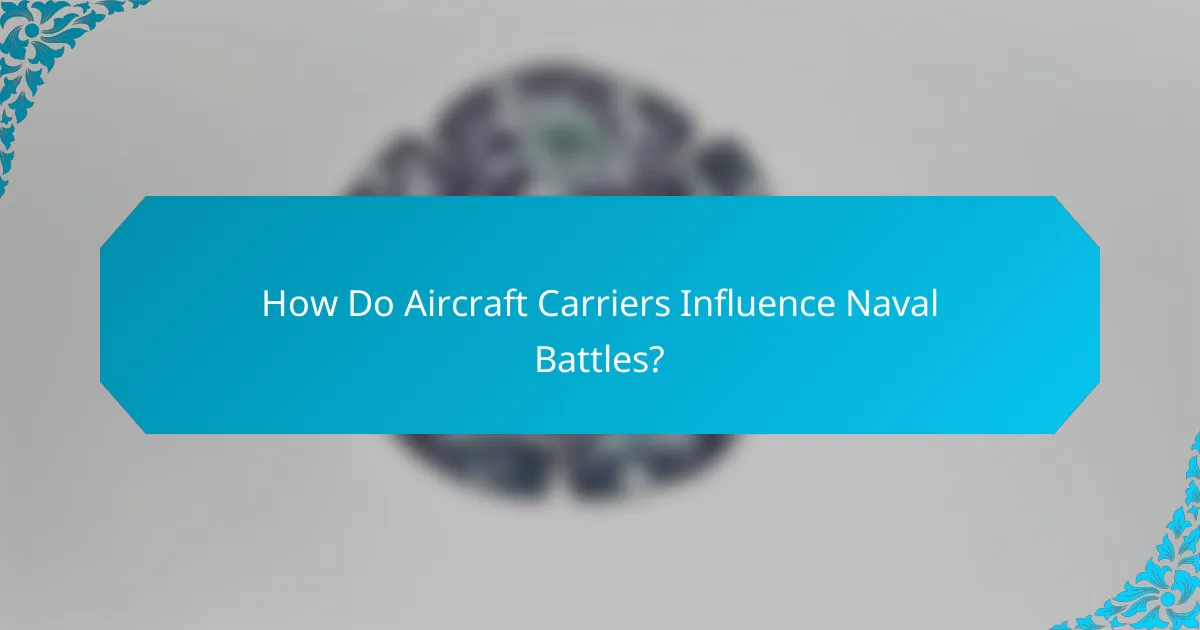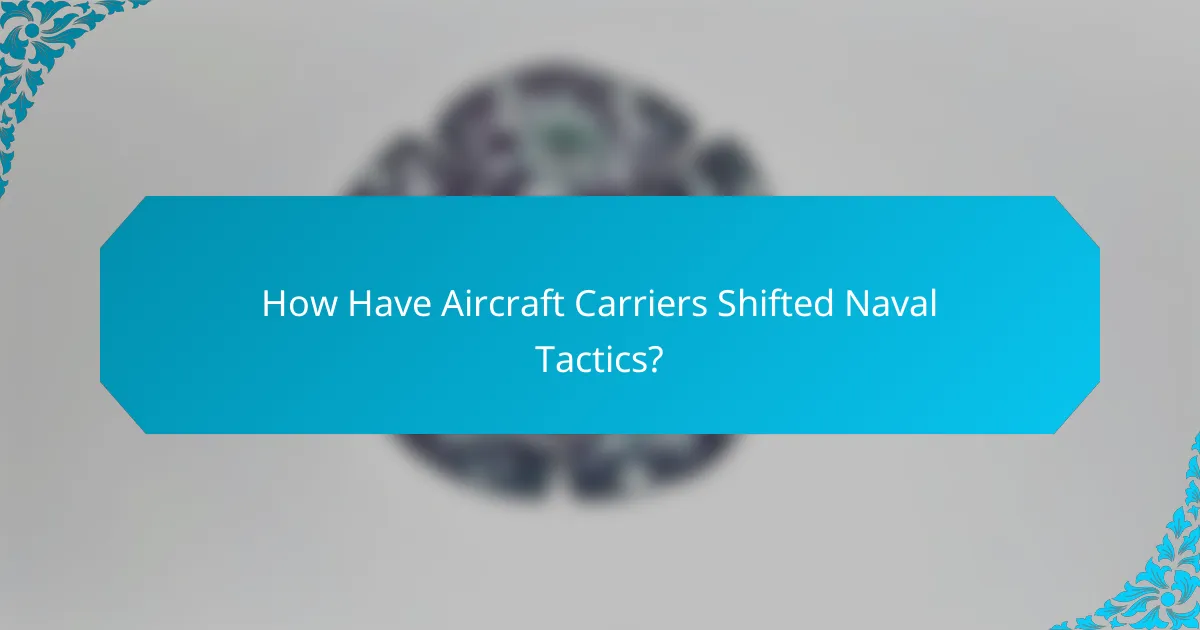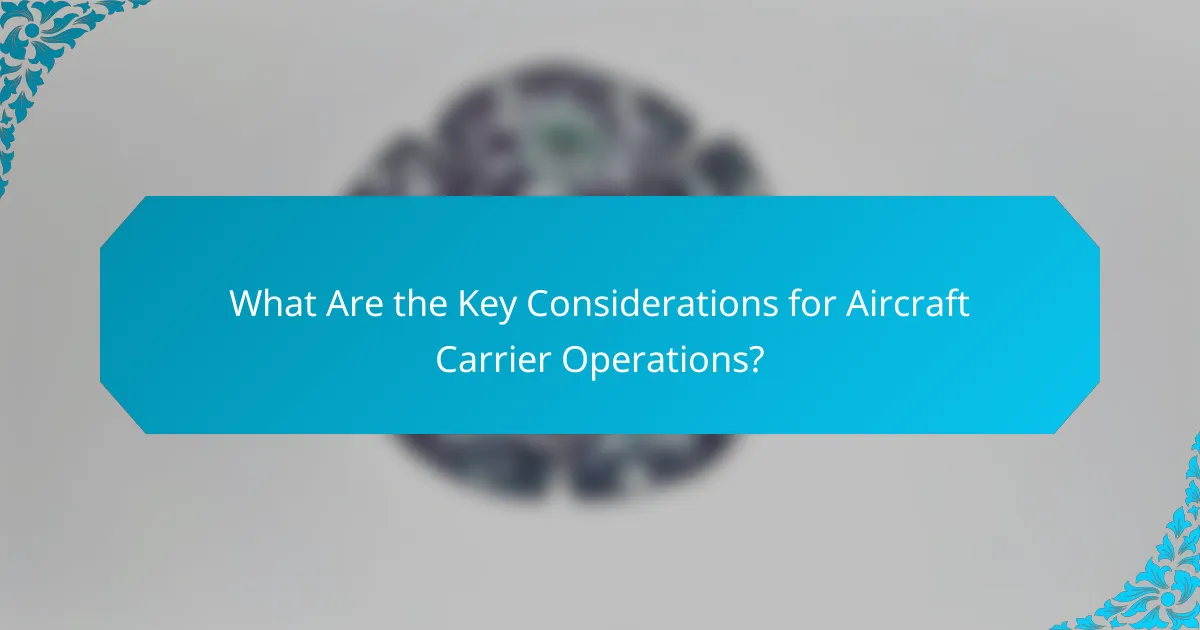Aircraft carriers have revolutionized naval warfare by acting as mobile airbases that enhance combat capabilities and power projection. Their unique ability to launch and recover aircraft from the sea provides strategic advantages, allowing nations to maintain a formidable presence in international waters and respond swiftly to emerging threats. This transformation has fundamentally altered naval tactics, enabling greater flexibility and responsiveness in maritime operations.

How Do Aircraft Carriers Influence Naval Battles?
Aircraft carriers significantly influence naval battles by serving as mobile airbases, enabling power projection and enhancing combat capabilities. Their ability to launch and recover aircraft from the sea allows for strategic advantages in various combat scenarios.
Power projection capabilities
Aircraft carriers enhance power projection by allowing nations to deploy air power far from their shores. This capability enables rapid response to crises and the ability to conduct operations in regions where land bases may not be available or accessible.
With the ability to carry dozens of aircraft, carriers can deliver air strikes, conduct reconnaissance, and provide air support for ground forces, making them a formidable presence in any naval engagement.
Force multiplier effects
Aircraft carriers act as force multipliers by amplifying the effectiveness of naval forces. They enable a smaller fleet to project greater combat power through air superiority and support operations, which can significantly alter the dynamics of a naval battle.
For instance, a carrier strike group can coordinate air and naval assets to overwhelm an opponent, making it difficult for them to respond effectively. This synergy increases the overall combat effectiveness of the fleet.
Strategic deterrence
Aircraft carriers serve as a tool for strategic deterrence, signaling military capability and resolve to potential adversaries. Their presence in a region can deter aggression by showcasing a nation’s willingness and ability to respond to threats.
The mere deployment of a carrier group can influence diplomatic negotiations and military posturing, as adversaries may reconsider their actions in light of the potential consequences of engaging with a carrier-supported force.
Operational flexibility
Operational flexibility is a key advantage of aircraft carriers, allowing them to adapt to various mission profiles, from combat operations to humanitarian assistance. This versatility enables naval forces to respond to a wide range of scenarios effectively.
Carriers can quickly shift from offensive operations to defensive postures, providing air cover for allied forces or conducting search and rescue missions, which enhances their overall utility in modern warfare.
Historical case studies
Historical examples illustrate the impact of aircraft carriers on naval battles. The Battle of Midway in World War II showcased how carrier-based aircraft could decisively change the outcome of engagements, leading to a significant shift in naval power dynamics.
More recently, during the Gulf War, aircraft carriers played a crucial role in launching air strikes that contributed to the rapid success of coalition forces. These case studies highlight the enduring relevance of carriers in shaping naval warfare strategies.

What Strategic Advantages Do Aircraft Carriers Provide?
Aircraft carriers offer significant strategic advantages in naval warfare, primarily through their ability to project air power, enhance logistical capabilities, and facilitate rapid military responses. These floating airbases enable nations to maintain a strong presence in international waters, influencing conflicts and deterring adversaries.
Air superiority
Aircraft carriers play a crucial role in achieving air superiority during naval battles. They deploy fighter jets and support aircraft that can engage enemy forces, protect fleet assets, and conduct reconnaissance missions. This capability allows a carrier strike group to dominate the airspace, which is vital for the success of naval operations.
For example, during the Gulf War, aircraft carriers provided essential air cover for ground troops, demonstrating their effectiveness in establishing control over the battlefield. Maintaining air superiority can significantly reduce the risk of enemy attacks on naval vessels and ground forces.
Logistical support
Aircraft carriers serve as mobile logistical hubs, enabling sustained operations far from home ports. They can supply fuel, ammunition, and spare parts to aircraft and other naval vessels, ensuring that operations continue without interruption. This logistical capability is essential for prolonged engagements and enhances the overall effectiveness of naval forces.
Additionally, carriers can support humanitarian missions and disaster relief efforts by delivering supplies and personnel quickly to affected areas. Their ability to operate independently for extended periods makes them invaluable assets in both combat and non-combat scenarios.
Rapid response deployment
One of the key advantages of aircraft carriers is their ability to deploy rapidly in response to emerging threats. They can be positioned in strategic locations to deter aggression or to provide immediate support during crises. This flexibility allows nations to project power and influence without the need for extensive troop deployments.
For instance, the U.S. Navy often positions carriers in volatile regions, allowing for quick military responses to conflicts or humanitarian disasters. The presence of a carrier can act as a deterrent, reducing the likelihood of escalation by adversaries.
Intelligence gathering
Aircraft carriers are equipped with advanced radar and surveillance systems that enhance intelligence gathering capabilities. They can monitor vast areas of ocean and airspace, providing critical information about enemy movements and activities. This intelligence is vital for planning operations and making informed strategic decisions.
Moreover, carrier-based aircraft can conduct reconnaissance missions, collecting data that informs both tactical and strategic planning. The ability to gather real-time intelligence allows naval forces to adapt quickly to changing situations, increasing their chances of success in engagements.

How Have Aircraft Carriers Shifted Naval Tactics?
Aircraft carriers have fundamentally transformed naval tactics by enabling the projection of air power far beyond traditional ship ranges. This shift allows for greater flexibility and responsiveness in maritime operations, significantly altering how naval battles are fought.
Integration of air and sea power
The integration of air and sea power has become a cornerstone of modern naval strategy. Aircraft carriers serve as floating air bases, allowing naval forces to launch air strikes and conduct reconnaissance missions from the sea. This capability enhances the effectiveness of naval operations and provides a strategic advantage in both offensive and defensive scenarios.
For example, during conflicts, carrier-based aircraft can respond rapidly to emerging threats, providing support to ground forces or engaging enemy ships from a distance. This synergy between air and sea assets creates a more versatile and formidable naval presence.
Changes in fleet composition
The rise of aircraft carriers has led to significant changes in fleet composition, with a shift towards more balanced forces that include a variety of support vessels. Modern fleets typically consist of destroyers, submarines, and supply ships that work in tandem with carriers to enhance operational capabilities.
Naval planners now prioritize multi-role ships that can defend against air, surface, and submarine threats, reflecting the need for a comprehensive approach to maritime security. This evolution ensures that fleets are better equipped to handle diverse challenges in contemporary warfare.
Impact on naval warfare doctrines
The advent of aircraft carriers has prompted a reevaluation of naval warfare doctrines, emphasizing the importance of air superiority in maritime engagements. Naval strategies now incorporate the use of carriers as central components in achieving mission objectives, often prioritizing air operations over traditional ship-to-ship combat.
As a result, doctrines have shifted towards concepts such as “sea control” and “power projection,” where the ability to dominate the airspace above the sea is critical. This change underscores the necessity for navies to invest in advanced aircraft and technologies to maintain competitive advantages in future conflicts.

What Are the Key Considerations for Aircraft Carrier Operations?
Key considerations for aircraft carrier operations include maintenance and operational costs, technological advancements, and personnel training requirements. Each of these factors significantly influences the effectiveness and sustainability of carrier-based naval power.
Maintenance and operational costs
Maintenance and operational costs for aircraft carriers are substantial and can vary widely depending on the class and age of the vessel. Annual budgets can range from hundreds of millions to several billion USD, encompassing fuel, repairs, and personnel expenses.
Regular maintenance is crucial to ensure the carrier remains combat-ready. This includes dry-docking for hull inspections, system upgrades, and routine checks on aircraft and equipment. Failure to maintain these vessels can lead to costly repairs and operational downtimes.
Technological advancements
Technological advancements play a pivotal role in enhancing the capabilities of aircraft carriers. Innovations in radar, weapons systems, and aircraft design improve operational effectiveness and adaptability in various combat scenarios.
Modern carriers often integrate advanced systems such as electromagnetic aircraft launch systems (EMALS) and improved stealth technologies. These advancements not only increase the strike range but also enhance the survivability of the carrier in contested environments.
Personnel training requirements
Personnel training requirements for aircraft carrier operations are extensive, reflecting the complexity of the systems and the need for high levels of coordination. Crew members must undergo rigorous training programs that can last several months to years, depending on their roles.
Training includes simulations, live exercises, and specialized courses for operating advanced aircraft and systems. Continuous training is essential to maintain readiness and ensure that personnel can effectively respond to dynamic combat situations.

How Do Different Countries Utilize Aircraft Carriers?
Countries utilize aircraft carriers to project military power, enhance naval capabilities, and support various strategic objectives. These floating airbases enable rapid deployment of air support, surveillance, and strike capabilities across vast maritime regions.
United States Navy strategies
The United States Navy employs aircraft carriers as central components of its blue-water strategy, allowing for global reach and power projection. Carriers serve as platforms for air superiority, enabling the U.S. to conduct operations in diverse environments, from combat missions to humanitarian assistance.
Typically, a U.S. carrier strike group includes a carrier, destroyers, submarines, and support vessels, enhancing its operational flexibility. This integrated approach allows for rapid response to crises, deterrence of adversaries, and support for allied forces.
Royal Navy deployments
The Royal Navy utilizes aircraft carriers to maintain a forward presence and enhance its operational capabilities. Recent deployments have focused on areas like the Indo-Pacific, where the UK aims to strengthen alliances and demonstrate commitment to global security.
With the introduction of the Queen Elizabeth-class carriers, the Royal Navy can project air power and support joint operations with NATO allies. These carriers are equipped to operate advanced aircraft, increasing their versatility in various mission profiles.
Chinese naval expansion
China’s utilization of aircraft carriers reflects its growing maritime ambitions and desire for regional dominance. The Chinese Navy is rapidly expanding its carrier fleet, aiming to enhance its ability to conduct operations in the South China Sea and beyond.
China’s carriers are central to its strategy of asserting territorial claims and projecting power. The development of indigenous carriers, such as the Shandong, signifies a shift towards self-reliance in naval capabilities, allowing for more sustained operations in contested areas.
Indian Ocean presence
Countries with interests in the Indian Ocean are increasingly utilizing aircraft carriers to secure trade routes and counter regional threats. Nations like India and the U.S. are enhancing their naval capabilities to ensure maritime security and stability in this vital area.
India’s aircraft carrier, INS Vikrant, is a key asset in its strategy to project power and protect its interests in the Indian Ocean Region. Collaborative exercises with other nations, including the U.S. and Japan, further strengthen maritime partnerships and enhance operational readiness.



